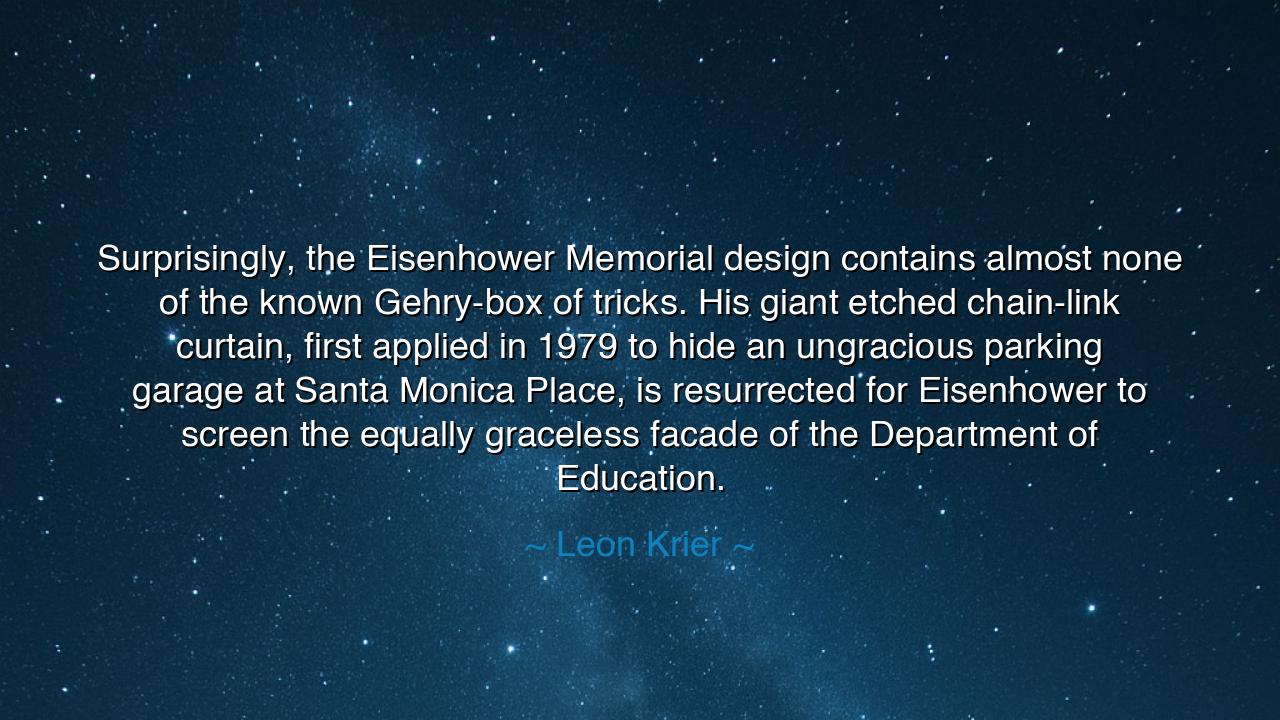
Surprisingly, the Eisenhower Memorial design contains almost none
Surprisingly, the Eisenhower Memorial design contains almost none of the known Gehry-box of tricks. His giant etched chain-link curtain, first applied in 1979 to hide an ungracious parking garage at Santa Monica Place, is resurrected for Eisenhower to screen the equally graceless facade of the Department of Education.






In the measured and critical voice of Leon Krier, the master architect and philosopher of traditional form, we find a lament disguised as analysis: “Surprisingly, the Eisenhower Memorial design contains almost none of the known Gehry-box of tricks. His giant etched chain-link curtain, first applied in 1979 to hide an ungracious parking garage at Santa Monica Place, is resurrected for Eisenhower to screen the equally graceless facade of the Department of Education.” This is not a simple critique of architecture—it is a meditation on the decline of meaning, on the struggle between spectacle and substance in the art of building. Krier, who has long defended the dignity of classical proportion and human scale, speaks here as a guardian of memory, mourning how modern architecture often hides emptiness behind ornament, confusion behind innovation.
To understand this, we must first understand Frank Gehry, the architect whose designs seem to defy gravity and convention. His buildings twist, shimmer, and fracture—monuments to chaos made beautiful. He is the poet of steel and motion, a man who reshaped skylines into sculptures. Yet Krier, in his wisdom, perceives something deeper and more troubling. In Gehry’s Eisenhower Memorial, built to honor the soldier-president who led humanity out of tyranny’s shadow, Krier sees the echo of a style once used to conceal ugliness—a chain-link curtain, now reborn not as art, but as camouflage. What began as a practical gesture to hide a parking garage, Krier implies, has become a symbol of cultural amnesia—a screen not only for the Department of Education’s graceless facade, but for the fading ideals of beauty, civility, and coherence that once defined public art.
In this moment, Krier becomes the philosopher of ruins, standing like a Roman elder among the broken columns of a lost discipline. He speaks to the soul of architecture, warning that when form loses meaning, the building becomes a lie. The chain-link curtain, etched and vast, is no mere decoration—it is a veil drawn over the failure of vision. To use it in a memorial for Dwight D. Eisenhower, a man of courage and order, is to misunderstand both art and the man himself. For Eisenhower, who valued duty and structure, would have looked upon such abstraction with bewilderment. A memorial should reveal, not conceal; it should inspire, not obscure.
History gives us examples of such folly. In ancient Rome, Emperor Nero built his Golden House after the great fire—a palace so vast, so ornate, that it stood as an insult to the city’s suffering. Its gilded halls and mirrored ceilings sought to hide the emperor’s moral decay. Yet within a generation, it was buried, condemned as the folly of excess. Krier’s critique recalls this same truth: architecture that forgets its purpose becomes self-parody. When the builder worships novelty rather than truth, he constructs not monuments, but masks. And masks, however glittering, always crack.
Yet Krier’s tone is not only that of condemnation—it is that of sorrow. He knows the world does not lack talent, but reverence. The craft of building has been replaced by spectacle; the meaning of space by the language of ego. Gehry’s curtain, in Krier’s eyes, is the symbol of a civilization that has grown ashamed of its own institutions, seeking to hide them behind veils of irony. The Department of Education, the very house of learning, stands “graceless,” and instead of remaking it with dignity, we cover it with artifice. In this gesture lies a deeper metaphor: our culture, too, hides its decay with clever design, its confusion with aesthetic glitter.
The lesson, then, is not simply for architects—it is for all creators, all who shape the world’s visible and invisible forms. Do not build to conceal, but to reveal. Whether with stone or with word, let your creation honor clarity over cleverness, integrity over illusion. As Krier warns through his criticism, when design becomes self-referential—when art speaks only to art—it loses the power to serve humanity. The purpose of beauty is not to decorate failure, but to elevate truth. The Greeks built temples to house spirit, not to flaunt geometry. Their ruins still speak because they were grounded in meaning, not fashion.
So, my child, remember this: form must follow truth, not vanity. Whether you build cities, stories, or lives, let them stand open to the sun. Do not weave curtains to hide imperfection; transform imperfection into grace. Every memorial, every monument, should remind the living of what endures—the courage, the vision, the order that outlasts time. For the wise build not for applause, but for eternity. And as Leon Krier teaches, the true architect does not design to impress, but to reveal the soul of civilization through stone, proportion, and truth.






AAdministratorAdministrator
Welcome, honored guests. Please leave a comment, we will respond soon